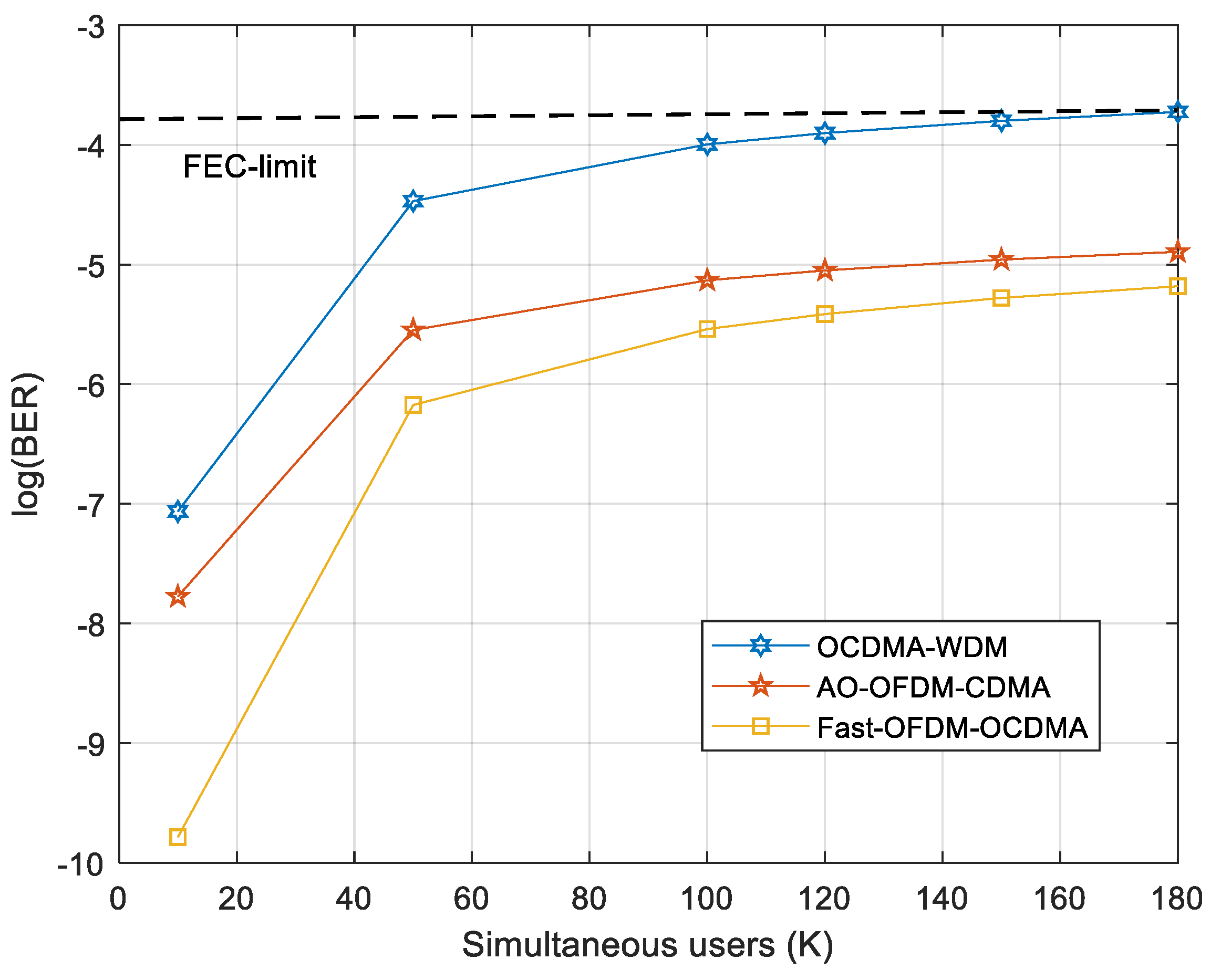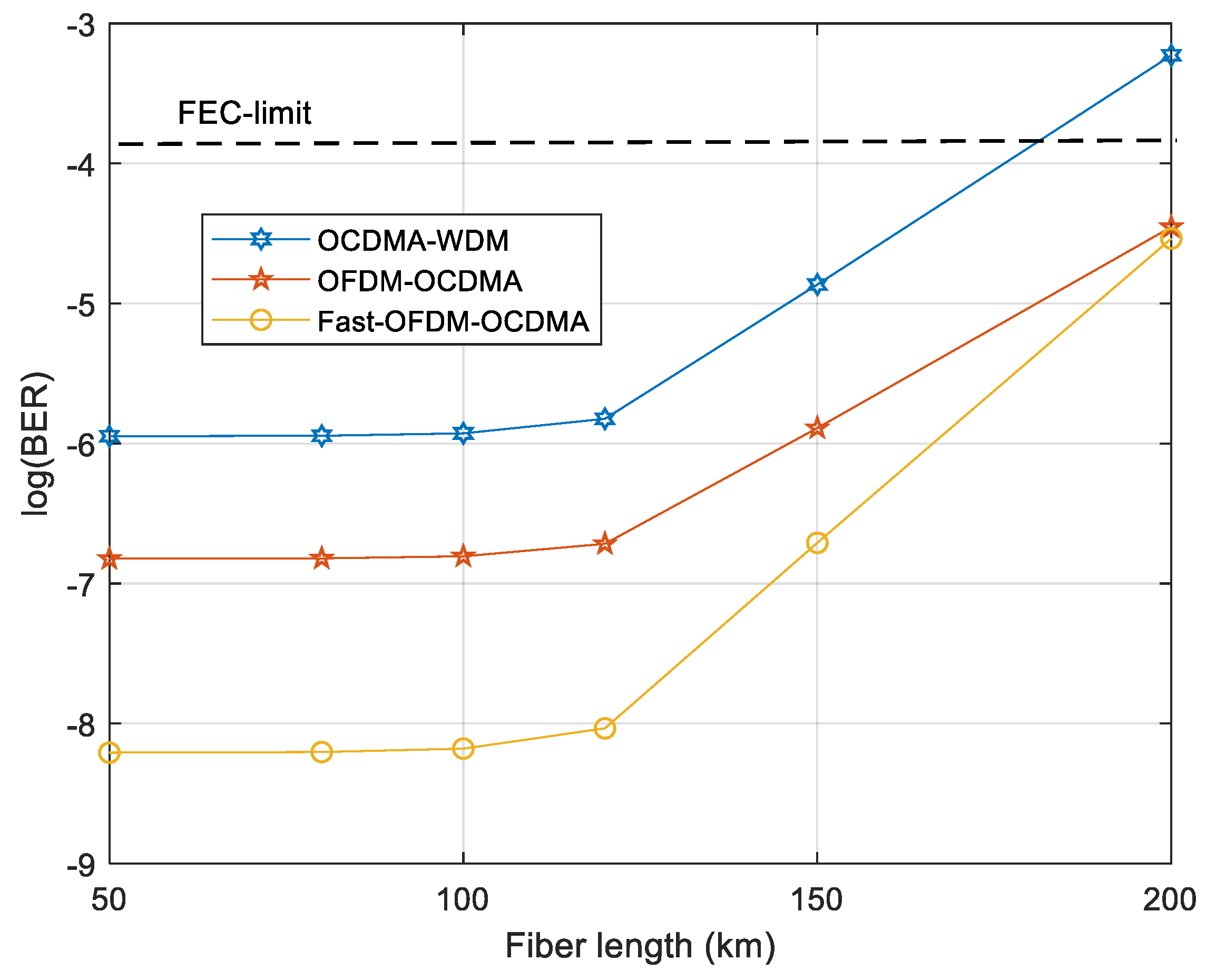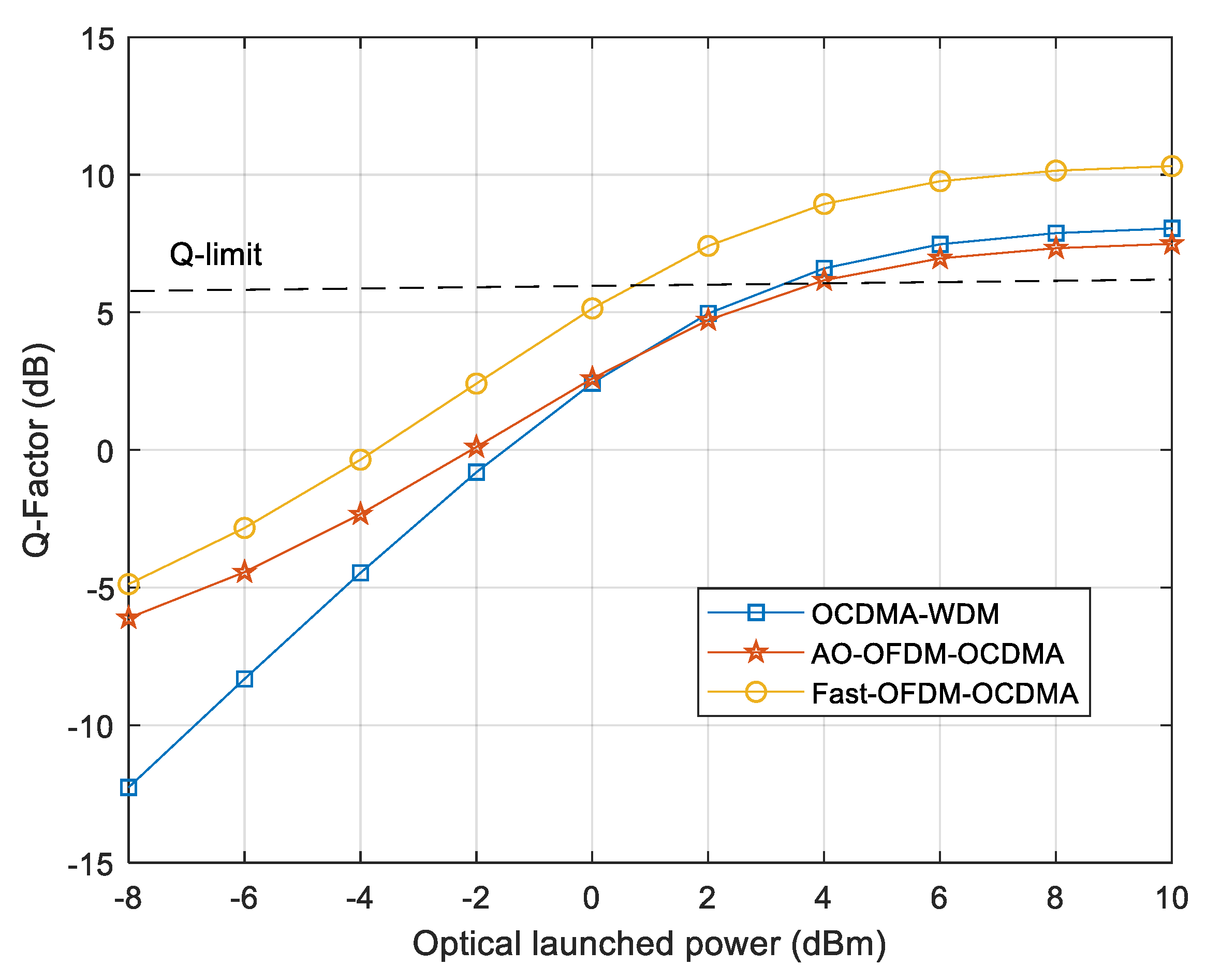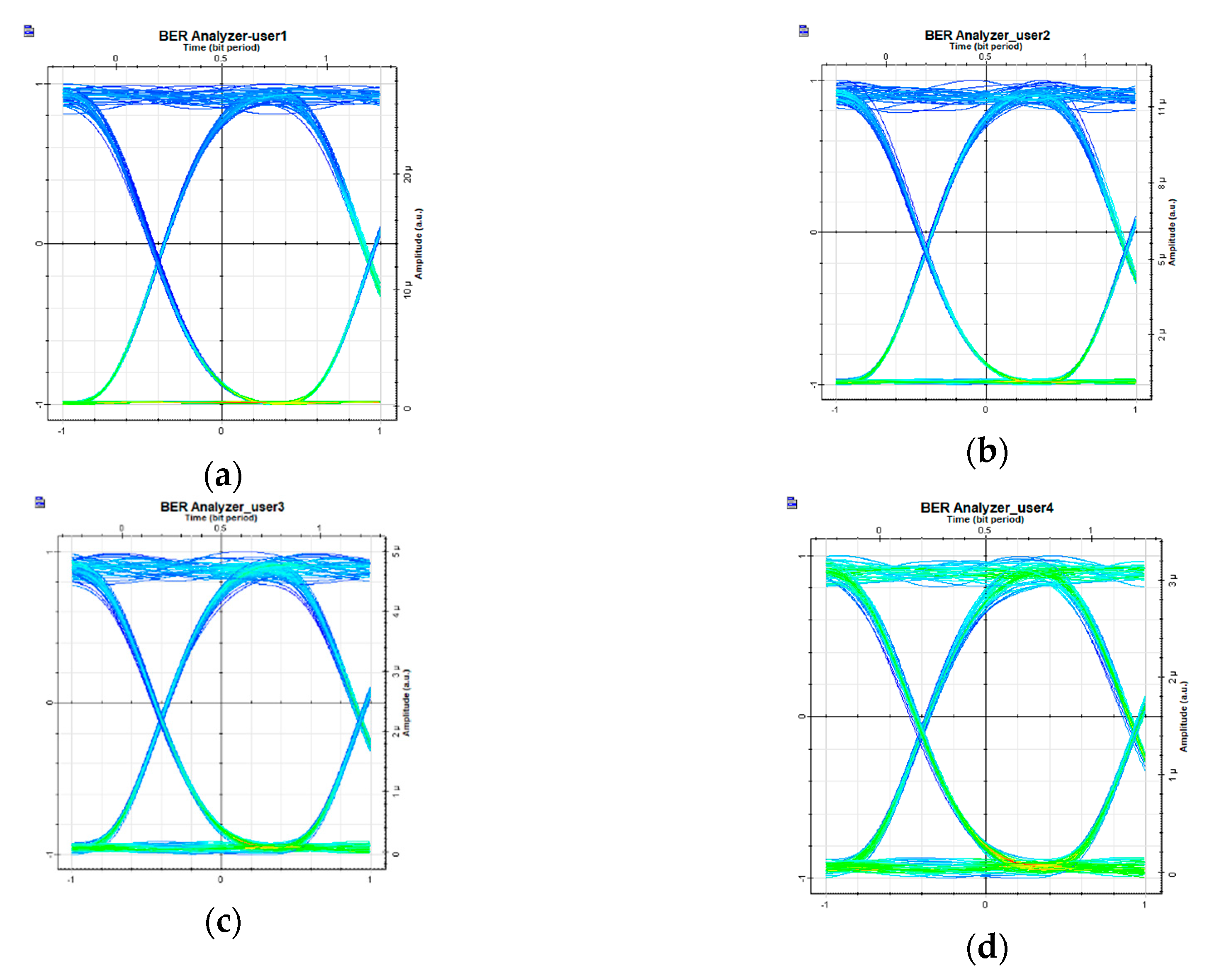A Performance Analysis of a Hybrid OCDMA-PON Configuration Based on IM/DD Fast-OFDM Technique for Access Network
Abstract
1. Introduction
2. IM/DD Fast-OFDM-CDMA System Architecture
3. Analytical System Model
4. Analytical Results
4.1. MAI Impact
4.2. Fiber Length Effect
4.3. Optical Launched Power Effect
5. Numerical Results
6. Power Budget Analysis
7. Conclusions
Funding
Conflicts of Interest
References
- Giacoumidis, E.; Mhatli, S.; Stephens, M.F.C.; Tsokanos, A.; Wei, J.; McCarthy, M.E.; Doran, N.J.; Ellis, A.D. Reduction of Nonlinear Inter-Subcarrier Intermixing in Coherent Optical OFDM by a Fast Newton-based Support Vector Machine Nonlinear Equalizer. J. Lightwave Technol. 2017, 35, 2391–2397. [Google Scholar] [CrossRef]
- Mhatli, S.; Mrabet, H.; Dayoub, I.; Giacoumidis, E. A novel support vector machine robust model based electrical equaliser for coherent optical orthogonal frequency division multiplexing systems. IET Commun. J. 2017, 11, 1091–1096. [Google Scholar] [CrossRef]
- Zhang, G.; de Leenheer, M.; Morea, A.; Mukherjee, B. A survey on OFDM-based elastic core optical networking. Commun. Surv. Tuts. 2013, 15, 65–87. [Google Scholar] [CrossRef]
- Mao, T.; Wang, Z.; Wang, Q.; Chen, S.; Hanzo, L. Dual-Mode Index Modulation Aided OFDM. IEEE Access J. 2017, 5, 23871–23880. [Google Scholar]
- Vardakas, J.S.; Moscholios, I.D.; Logothetis, D.; Stylianakis, G. Performance Analysis of OCDMA PONs Supporting Multi-Rate Bursty Traffic. IEEE Trans. Commun. 2013, 61, 3374–3384. [Google Scholar] [CrossRef]
- Guo, X.; Wang, Q.; Zhou, L.; Fang, L.; Li, X.; Wonfor, A.; Penty, R.V.; White, I.H. 16-user OFDM-CDMA optical access network. In Proceedings of the Conference of Lasers and Electro-Optics (CLEO), San Jose, CA, USA, 5–10 June 2016. [Google Scholar]
- Zhang, Z.; Tian, F.; Zeng, F.; Ge, L.; Xuan, G. Mutually Orthogonal Complementary Pairs for OFDM-CDMA Systems. In Proceedings of the International Conference on Signal Processing (ICSP), Hangzhou, China, 19–23 October 2014. [Google Scholar]
- Yang, C. Spectral efficiency of the optical CDMA based-PONs using two-codes keying. IEEE Commun. Lett. 2010, 14, 767–769. [Google Scholar] [CrossRef]
- Saghari, P.; Omrani, R.; Willner, A.E.; Kumar, P.V. Analytical Interference Model for Two-Dimensional (Time–Wavelength) Asynchronous O-CDMA Systems Using Various Receiver Structures. J. Lightwave Technol. 2005, 23, 3260–3269. [Google Scholar] [CrossRef]
- Muciaccia, T.; Gargano, F.; Passaro, V.M.N. Passive Optical Access Networks: State of the Art and Future Evolution. Photonics J. 2014, 1, 323–346. [Google Scholar] [CrossRef]
- Ahmed, N.; Rashid, M.A.; Islam, M. OCDMA/WDM system with DPSK modulation at 2.5Gbps for GPON application. In Proceedings of the 2nd Workshop on Recent Trends in Telecommunications Research (RTTR), Palmerston North, New Zealand, 1–3 February 2017. [Google Scholar]
- Alves, T.A.B.; Durand, F.R.; Angelico, B.A.; Abrao, T. Power allocation scheme for OCDMA NG-PON with proportional–integral–derivative algorithms. IEEE OSA J. Opt. Commun. Netw. 2016, 8, 645–655. [Google Scholar] [CrossRef]
- Mrabet, H.; Cherifi, A.; Raddo, T.; Dayoub, I.; Haxha, S. A Comparative Study of Asynchronous and Synchronous OCDMA Systems. IEEE Syst. J. 2020, 1–12. [Google Scholar] [CrossRef]
- Hadi, M.; Pakravan, M.R. Analysis and Design of Adaptive OCDMA Passive Optical Networks. J. Lightwave Technol. 2017, 35, 2853–2863. [Google Scholar] [CrossRef]
- Mrabet, H.; Mhatli, S.; Dayoub, I.; Giacoumidis, E. Performance analysis of AO-OFDM-CDMA with advanced 2D-hybrid coding for amplifier-free LR-PONs. IET Optoelectron. 2018, 12, 293–298. [Google Scholar] [CrossRef]
- Mrabet, H.; Dayoub, I.; Haxha, S.; Attia, R. Performance analysis of 2D-OCDMA system in long-reach passive optical network. Opt. Laser Technol. 2019, 117, 64–72. [Google Scholar] [CrossRef]
- Mrabet, H.; Bahloul, F.; Amari, A.; Wen, Y.; Giacoumidis, E. Performance analysis of a hybrid 100G CO-OFDM-CDMA system with 2D signature for LR-PONs. In Proceedings of the ICTON 2020, Bari, Italy, 19–23 July 2020. [Google Scholar]
- Yousif, B.; El Metwally, I.; Samra, A.S. A modified topology achieved in OFDM/SAC-OCDMA-based multi-diagonal code for enhancing spectral efficiency. Photonic Netw. Commun. 2019, 37, 90–99. [Google Scholar] [CrossRef]
- Cherifi, A.; Yagoubi, B.; Bouazza, B.S.; Dahman, A.O. New Method for the Construction of Optical Zero Cross Correlation Code Using Block Matrices in OCDMA-OFDM System. J. Telecommun. Electron. Comput. Eng. 2016, 8, 33–39. [Google Scholar]
- Giacoumidis, E.; Ibrahim, S.K.; Zhao, J.; Tang, J.M.; Ellis, A.D.; Tomkos, I. Experimental and Theoretical Investigations of Intensity-Modulation and Direct-Detection Optical Fast-OFDM over MMF-links. IEEE Photonics Technol. Lett. 2012, 24, 52–54. [Google Scholar] [CrossRef]
- Giacoumidis, E.; Tsokanos, A.; Mouchos, C.; Zardas, G.; Alves, C.; Wei, J.L.; Tang, J.M.; Gosset, C.; Jaouën, Y.; Tomkos, I. Extensive Comparisons of Optical Fast-OFDM and Conventional Optical OFDM for Local and Access Networks. IEEE OSA J. Opt. Commun. Netw. 2012, 4, 724–733. [Google Scholar] [CrossRef]
- Jarajreh, M.A. Reduced-Complexity Artificial Neural Network Equalization for Ultra-High-Spectral-Efficient Optical Fast-OFDM Signals. Appl. Sci. 2019, 9, 4038. [Google Scholar] [CrossRef]
- Mrabet, H.; Dayoub, I.; Attia, R. A Comparative Study of 2D-OCDMA-WDM System Performance in 40G-PON Context. IET Optoelectron. 2017, 11, 141–147. [Google Scholar] [CrossRef]
- Shieh, W.; Djordjevic, I. OFDM for Optical Communications; Elsevier: Amsterdam, The Netherlands, 2010. [Google Scholar]
- Amari, A.; Dobre, O.A.; Venkatesan, R.; Kumar, O.S.S.; Ciblat, P.; Jaouën, Y. A survey on fiber nonlinearity compensation for 400 Gbps and beyond optical communication systems. IEEE Commun. Surv. Tuts. 2017, 19, 3097–3113. [Google Scholar] [CrossRef]
- Wang, D.; Lei, C.; Luo, R.; Chen, H.; Chen, M.; Yang, S.; Xie, S. 16QAM optical fast-OFDM transmission system based on discrete fourier transform and frequency multiplexing. In Proceedings of the 2014 OptoElectronics and Communication Conference and Australian Conference on Optical Fibre Technology, Melbourne, Australia, 6–10 July 2014; pp. 445–446. [Google Scholar]
- Matsumoto, R.; Kodama, T.; Shimizu, S.; Nomura, R.; Omichi, K.; Wada, N.; Kitayama, K. 40G-OCDMA-PON system with asymmetric structure using multi-port and sampled SSFBG encoder/decoders. J. Lightwave Technol. 2014, 32, 1132–1143. [Google Scholar] [CrossRef]
- Brown, G. The Optics Encyclopedia (Basic Foundations and Practical Applications); Wiley: Hoboken, NJ, USA, 2004. [Google Scholar]
- Mhatli, S.; Mrabet, H.; Dayoub, I.; Giacoumidis, E. Performance evaluation of an IMDD optical OFDM-CDMA system. Appl. Opt. 2018, 57, 1569–1574. [Google Scholar] [CrossRef] [PubMed]
- Yousif Ahmed, H.; Zeghid, M.; A.Imtiaz, W.; Sharma, T.; Chehri, A.; Fortier, P. Two-Dimensional Permutation Vectors’ (PV) Code for Optical Code Division Multiple Access Systems. Entropy 2020, 22, 576. [Google Scholar] [CrossRef]
- Hassan, K.; Masarra, M.; Zwingelstein, M.; Dayoub, I. Channel Estimation Techniques for Millimeter-Wave Communication Systems: Achievements and Challenges. IEEE Open J. Commun. Soc. 2020, 1, 1336–1363. [Google Scholar] [CrossRef]
- Benieddi, A.; Elahmar, S.A.; Dayoub, I.; Haxha, S. Blind Adaptive Low-Complexity Time-Domain Equalizer for 100-Gb/s Direct-Detection Optical OFDM Systems Over Long-Reach SSMF. IEEE Syst. J. 2020, 1–7. [Google Scholar] [CrossRef]
- Mrabet, H.; Belguith, S.; Alhomoud, A.; Jemai, A. A Survey of IoT Security Based on a Layered Architecture of Sensing and Data Analysis. Sensors 2020, 20, 3625. [Google Scholar] [CrossRef] [PubMed]









| S0H1 | 30000000 | 20000000 | 70000000 | 00000000 | 00000000 | 10000000 | 00000000 |
|---|---|---|---|---|---|---|---|
| S2H1 | 50000000 | 40000000 | 20000000 | 00000000 | 00000000 | 30000000 | 00000000 |
| S4H1 | 20000000 | 10000000 | 60000000 | 00000000 | 00000000 | 70000000 | 00000000 |
| S1H2 | 10000000 | 70000000 | 50000000 | 00000000 | 00000000 | 60000000 | 00000000 |
| S3H2 | 40000000 | 30000000 | 10000000 | 00000000 | 00000000 | 20000000 | 00000000 |
| S0H3 | 60000000 | 50000000 | 30000000 | 00000000 | 00000000 | 40000000 | 00000000 |
| S2H3 | 70000000 | 60000000 | 40000000 | 00000000 | 00000000 | 50000000 | 00000000 |
| Parameter | Value |
|---|---|
| Signal bit-rate | 40 Gb/s |
| Modulation order | 16 QAM |
| Cyclic prefix length | 0.125 |
| Data subcarrier number | 64 |
| Launched power, operating wavelength | 10 dBm, 1550 nm |
| SMF attenuation | 0.2 dB/km |
| Default SSMF length | 80 km |
| CW laser spectral width () | 0.15 Mhz |
| 2D-HC OCDMA code length | 49 |
| 2D-HC OCDMA code weight | 4 |
| 2D-HC OCDMA chip period | 8.06 × 10−13 |
| 2D-HC average probability hit of chips (H) | 0.53 |
| Lower Case | Upper Case | |
|---|---|---|
| Emitted average power (dBm) | 4 | 15 |
| Connectors attenuation (dB) | −1.6 | −1.6 |
| Splitter attenuation (dB) | −12 | −12 |
| System margin (dB) | −3 | −3 |
| Received average power (dBm) | −(−35) | −(−35) |
| = Available attenuation | 22.4 | 33.4 |
| Maximal distance between ONU and OLT() | 112 km | 167 km |
| Parameter | OCDMA-WDM | AO-OFDM-CDMA | Fast-OFDM-CDMA |
|---|---|---|---|
| Emitted average power (dBm) | 15 | 10 | 10 |
| Connectors attenuation (dB) | −3.6 | −2.4 | −1.6 |
| Splitter attenuation (dB) | −27 | −18 | −12 |
| System margin (dB) | −3 | −3 | −3 |
| Received average power (dBm) | −(−35) | −(−35) | −(−35) |
| = Available attenuation | 16.4 | 21.6 | 28.4 |
| Maximal distance between ONU and OLT() | 82 km | 108 km | 142 km |
| System | Coding Scheme | Cardinality | Performance | System Components | Reachability (km) |
|---|---|---|---|---|---|
| AO-OFDM-CDMA [15] | 2D-HC | 45 | BER ≤ FEC limit | DFB + SMF + APD | 108 |
| 2D-OCDMA [16] | 2D-PHS 2D-HC | 190 120 | Q-factor = 6 | DFB + SMF + APD | 120 190 |
| CO-OFDM-CDMA [17] | 2D-PHS 2D-HC | 16 | BER ≤ FEC limit | VCSEL + SMF + APD | 83.5 |
| 2D-OCDMA-WDM [23] | 2D-HC | 524 | BER ≤ 10 × 10−10 | VCSEL + SMF + APD | 82 |
| IMDD OOFDM-CDMA [29] | 2D-PHS | 5 | BER ≤ FEC limit | VCSEL + SMF + APD | 80 |
| 2D-PV [30] | 2D Permutation vectors’ code | 110 | BER ≤ 10 × 10−9 | LED + SMF + PIN | 20 |
| IM/DD FAST-OFDM-CDMA | 2D-HC | 180 | BER ≤ FEC limit | CWlaser + SMF + APD | 142 |
Publisher’s Note: MDPI stays neutral with regard to jurisdictional claims in published maps and institutional affiliations. |
© 2020 by the author. Licensee MDPI, Basel, Switzerland. This article is an open access article distributed under the terms and conditions of the Creative Commons Attribution (CC BY) license (http://creativecommons.org/licenses/by/4.0/).
Share and Cite
Mrabet, H. A Performance Analysis of a Hybrid OCDMA-PON Configuration Based on IM/DD Fast-OFDM Technique for Access Network. Appl. Sci. 2020, 10, 7690. https://doi.org/10.3390/app10217690
Mrabet H. A Performance Analysis of a Hybrid OCDMA-PON Configuration Based on IM/DD Fast-OFDM Technique for Access Network. Applied Sciences. 2020; 10(21):7690. https://doi.org/10.3390/app10217690
Chicago/Turabian StyleMrabet, Hichem. 2020. "A Performance Analysis of a Hybrid OCDMA-PON Configuration Based on IM/DD Fast-OFDM Technique for Access Network" Applied Sciences 10, no. 21: 7690. https://doi.org/10.3390/app10217690
APA StyleMrabet, H. (2020). A Performance Analysis of a Hybrid OCDMA-PON Configuration Based on IM/DD Fast-OFDM Technique for Access Network. Applied Sciences, 10(21), 7690. https://doi.org/10.3390/app10217690





